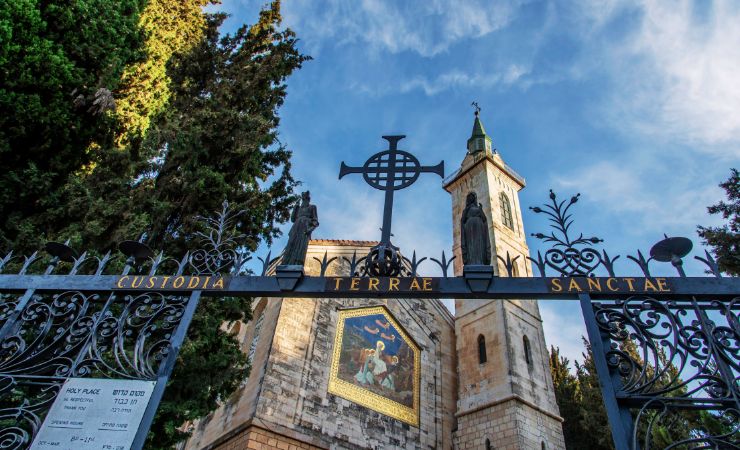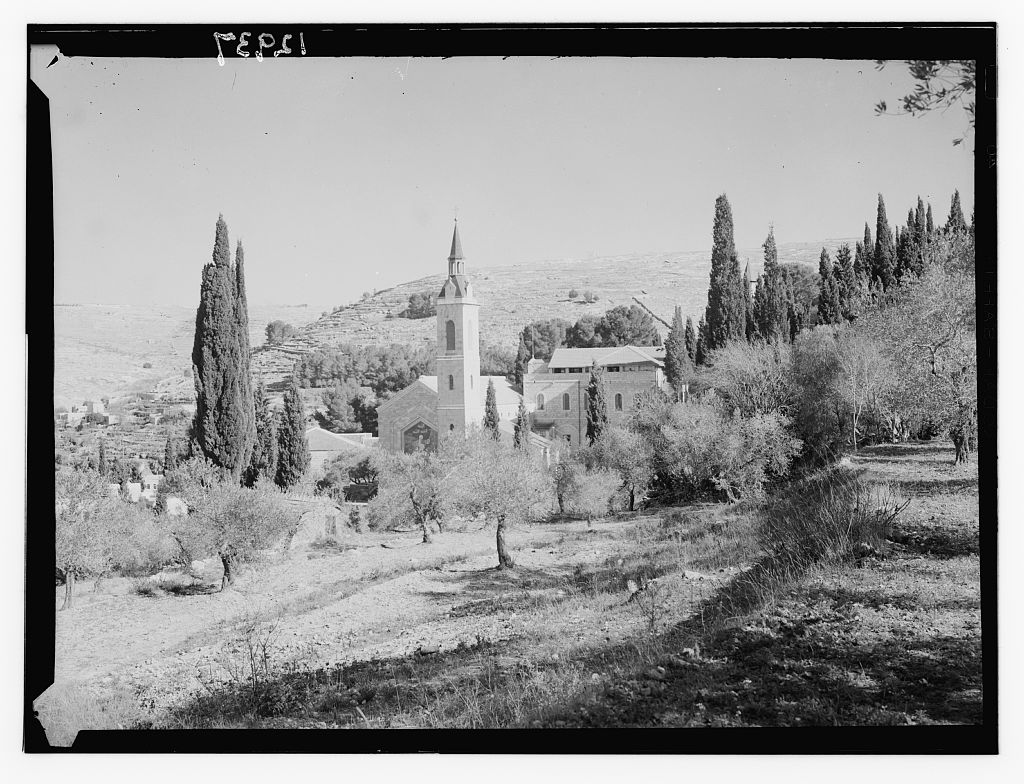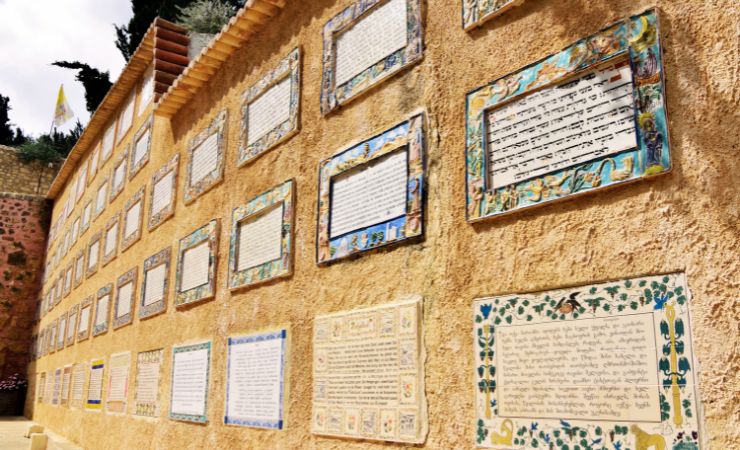The Church of the Visitation: Echoes of Faith in Ein Karem
Ein Karem, a village renowned for its historic charm and winding streets, is home to the Church of the Visitation. This church commemorates the biblical event when Mary, the mother of Jesus, visited her cousin Elizabeth, soon-to-be mother of John the Baptist.

Location
The Church of the Visitation is perched in Ein Karem, a village on the western outskirts of Jerusalem. Surrounded by the beauty of rolling hills and green landscapes, Ein Karem is a historical haven, characterized by its narrow lanes, age-old homes, and enchanting gardens.
Biblical context: The Meeting of Mary and Elizabeth
The meeting of Elizabeth and Mary occurred during a tumultuous period in Jewish history. The Roman Empire occupied the region, and the Jewish people were under Roman rule.
Upon learning from the Angel Gabriel that she would conceive a child through the Holy Spirit and that her relative Elizabeth was also miraculously pregnant in her old age, Mary decided to visit Elizabeth. The Gospel of Luke (1:39) states, “Mary arose in those days, and went into the hill country with haste, into a city of Juda.” This journey would not have been easy. Given the terrain and the means of travel in those times, Mary’s trip to “a town in the hill country of Judea” would have been arduous, possibly taking several days. Yet, driven by the divine revelation and a desire to share her joy with Elizabeth, Mary undertook this journey.
As Mary entered the house of Zechariah and greeted Elizabeth, something wondrous occurred:
And it came to pass, that, when Elisabeth heard the salutation of Mary, the babe leaped in her womb; and Elisabeth was filled with the Holy Ghost: And she spake out with a loud voice, and said, Blessed art thou among women, and blessed is the fruit of thy womb. And whence is this to me, that the mother of my Lord should come to me? For, lo, as soon as the voice of thy salutation sounded in mine ears, the babe leaped in my womb for joy. And blessed is she that believed: for there shall be a performance of those things which were told her from the Lord.
Recognition of the Divine: John the Baptist, still in Elizabeth’s womb, recognized the presence of Jesus in Mary’s womb. This leap is seen as the first acknowledgment of Christ’s divinity.
Elizabeth’s Prophetic Utterance: Filled with the Holy Spirit, Elizabeth proclaimed Mary’s unique role in salvation history and the blessedness of her unborn child, Jesus.
Mary’s Faith: Elizabeth commended Mary’s faith, emphasizing that the promises of the Lord would be fulfilled in her.
Following this divine encounter, Mary responded with the Magnificat (Luke 1:46-55), a profound hymn of praise to God, acknowledging His mercy, might, and faithfulness to His people.
Biblical context: The Murder of the Innocents
The “Murder of the Innocents” is a harrowing event recounted in the Gospel of Matthew. After the birth of Jesus in Bethlehem, wise men from the East visited King Herod in Jerusalem, inquiring about the newborn “King of the Jews.” They had seen his star and came to pay him homage. Disturbed by this news and feeling threatened by the prophecy of a new king, Herod deceitfully asked the wise men to find the child and report back, claiming he too wished to honor him.
However, when the wise men, warned in a dream, did not return to Herod, he became furious. To eliminate any potential threat to his throne, Herod ordered the massacre of all male infants two years old and under in Bethlehem and its vicinity, hoping to kill the newborn king in the process.
This brutal act was seen as the fulfillment of the prophecy in Jeremiah 31:15, where Rachel, symbolizing the people of Israel, weeps for her lost children
Then Herod, when he saw that he was mocked of the wise men, was exceeding wroth, and sent forth, and slew all the children that were in Bethlehem, and in all the coasts thereof, from two years old and under, according to the time which he had diligently inquired of the wise men.
According to Christian tradition, during the “Murder of the Innocents,” Elizabeth fled with her infant son, John the Baptist, to hide from Herod’s soldiers. It is believed that a mountain miraculously opened and provided shelter for them. This event is symbolically represented in the Church of the Visitation by the “Rock of Concealment.” The rock is a poignant reminder of the lengths to which Elizabeth went to protect her son from Herod’s decree.
Additionally, the church’s lower chapel features frescoes that depict various biblical events, including the Massacre of the Innocents. This serves as a visual representation of the dark times surrounding the early days of Jesus and John the Baptist, reminding visitors of the sacrifices and perils faced by the Holy Family and their kin.
In essence, while the primary focus of the Church of the Visitation is the joyful meeting of Mary and Elizabeth, it also stands as a testament to the broader narrative of hope, faith, and divine intervention amidst the darkest of times.




The Architecture of the 1955 Church of the Visitation
The church was designed by the renowned Italian architect Antonio Barluzzi in 1955. Barluzzi, often referred to as the “Architect of the Holy Land,” was responsible for designing many churches in the region such as the Church of All Nations, Dominus Flevit, and the Church of the Beatitudes.
Integration of Archaeological Findings into the Modern Church of the Visitation
Barluzzi’s design for the Church of the Visitation was not just an architectural endeavor but also an archaeological one. He seamlessly integrated the archaeological findings from different periods into the new structure, ensuring that the church’s rich history was preserved and highlighted.
Byzantine Period: One of the most significant remnants from the Byzantine era is a cistern located in the church’s courtyard. Instead of covering or removing this relic, Barluzzi incorporated it into the design, allowing visitors to view and appreciate this ancient water source. Additionally, traces of the Byzantine chapel were integrated into the layout, serving as a foundation upon which the new structure was built.
Crusader Period: The Crusaders had constructed a church on this site, and remnants of their architectural endeavors were still present. Barluzzi incorporated parts of the Crusader-era walls and structures into the new church. The ruins serve as a tangible link to the past, reminding visitors of the site’s long-standing religious significance.
Architectural Highlights of the 1955 Church:
Courtyard: The entrance courtyard is a focal point, adorned with ceramic tablets inscribed with the Magnificat in various languages. The base of the bell tower is from the time of the Crusaders. On the wall, you will be able to see the Magnificat in more than 40 languages.
Lower Church: The lower church, or the crypt, houses the “Rock of Concealment,” a significant site where tradition holds that Elizabeth and her son John were hidden from Herod’s soldiers. The design of this space is intimate, with frescoes depicting biblical events, including the Massacre of the Innocents. If you look up, you will see Antonio Barluzzi’s portrait integrated into the mural in the ceiling.
Upper Church: The upper church is airy and filled with light, a contrast to the crypt below. The walls are adorned with frescoes, many of them of power women from the Bible. Additional, you will encounter a facade features a mosaic commemorating the Visitation.

Is Ein Karem the Actual Site Mentioned in the Biblical?
While the Bible does not specifically name Ein Karem as the location, several factors contribute to the tradition that places the story there:
Geographical Context: Ein Karem is located in the hill country of Judea, fitting the biblical description. Its proximity to Jerusalem and the Judean hills aligns with the geographical context provided in the New Testament.
Early Christian Traditions: One of the earliest traditions that link Ein Karem to the biblical narrative is attributed to Empress Helena of Constantinople, the mother of Constantine I. During her pilgrimage to the Holy Land in the 4th century, she identified several biblical sites, including Ein Karem.
Archaeological Evidence: While archaeological excavations in Ein Karem have uncovered remnants of Byzantine and Crusader-era churches and chapels, direct evidence linking the village to the biblical story is elusive. However, the continuous Christian presence and the construction of churches and monasteries over the centuries suggest a longstanding tradition associating Ein Karem with the Visitation.
Centuries of Pilgrimage: Over the centuries, Ein Karem became a focal point for Christian pilgrims. The stories and traditions passed down through generations have solidified the village’s association with the Visitation of Mary to Elizabeth.
So while the Bible does not explicitly name Ein Karem as the site of the Church of the Visitation, a combination of geographical context, early Christian traditions, archaeological findings, and centuries of pilgrimage have established the village as the traditional location for this significant biblical event.
Sources and Additional Reading
BibleWalks – Visitation Church in Ein Kerem
Catholic Shrine Basilica – The Church of the Visitation
Sites Nearby the Church of the Visitation
Church of St. John Ba Harim: Traditionally believed to mark the birthplace of John the Baptist. Parts of the building dates back to the Byzantine era.
Mary’s Well: A spring that has been in use since ancient times and is located in the heart of the village.
Russian Orthodox Gorny Convent-Moscovia Monastery: This Russian Orthodox convent is also known as the “Convent of the Ascension”. It is a significant pilgrimage site and offers breathtaking views.
- The Sisters of Zion Monastery: This Catholic monastery is run by the Sisters of Zion, an order founded in the 19th century (see Convent of the Sisters of Zion in Jerusalem).
- Mount Herzl: Mount Herzl is the site of Israel’s national cemetery and other memorial and educational facilities.



